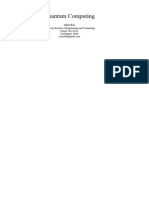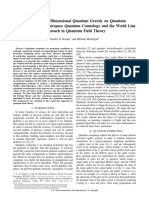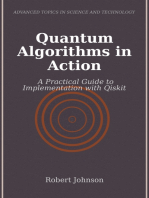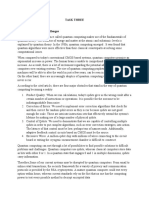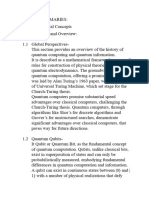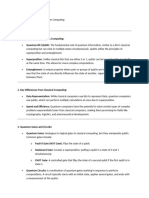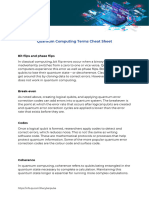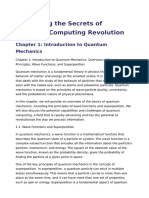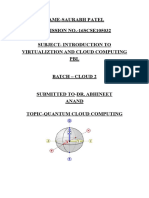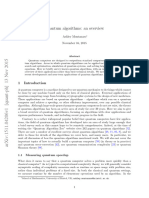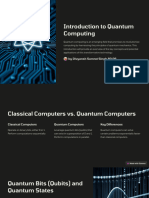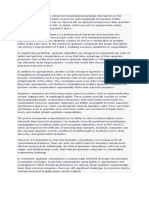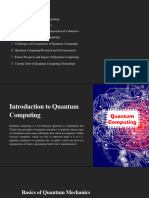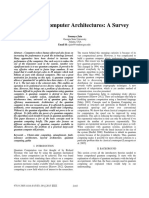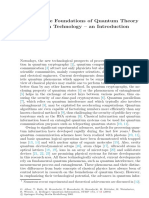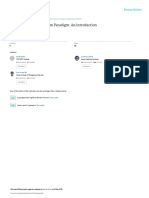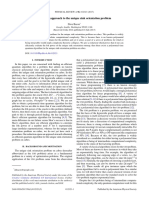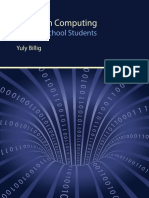0 ratings0% found this document useful (0 votes)
18 viewsQuantum Computing
Quantum Computing
Uploaded by
Lucus MouliCopyright:
© All Rights Reserved
Available Formats
Download as DOC, PDF, TXT or read online from Scribd
Quantum Computing
Quantum Computing
Uploaded by
Lucus Mouli0 ratings0% found this document useful (0 votes)
18 views6 pagesCopyright
© © All Rights Reserved
Available Formats
DOC, PDF, TXT or read online from Scribd
Share this document
Did you find this document useful?
Is this content inappropriate?
Copyright:
© All Rights Reserved
Available Formats
Download as DOC, PDF, TXT or read online from Scribd
Download as doc, pdf, or txt
0 ratings0% found this document useful (0 votes)
18 views6 pagesQuantum Computing
Quantum Computing
Uploaded by
Lucus MouliCopyright:
© All Rights Reserved
Available Formats
Download as DOC, PDF, TXT or read online from Scribd
Download as doc, pdf, or txt
You are on page 1of 6
Quantum Computing
Sanjay S, Manish P, & Shanmuga Prasanth
23bsds152sanjays@skacas.ac.in, 23bsds130manishp@skacas.ac.in, 23bsds155shanmugaprasanth@skacas.ac.in
II. ELEMENTS OF QUANTUM COMPUTING
Abstract— Changing the model underlying information and A. Bits and Qubits
computation from a classical mechanical to a quantum The state space of a physical system consists of all possible
mechanical one yields faster algorithms, novel cryptographic states of the system. Any quantum mechanical system that can
mechanisms, and alternative methods of communication. be modelled by a two dimensional complex vector space can
Quantum algorithms can perform a select set of tasks vastly
more efficiently than any classical algorithm, but for many tasks be viewed as a qubit. Such systems include photon
it has been proven that quantum algorithms provide no polarization, electron spin, and a ground state and an excited
advantage. The breadth of quantum computing applications is state of an atom. A key difference between classical and
still being explored. Major application areas include security and quantum systems is the way in which component systems
the many fields that would benefit from efficient quantum combine. The state of a classical system can be completely
simulation. The quantum information processing viewpoint characterized by the state of each of its component pieces. A
provides insight into classical algorithmic issues as well as a surprising and unintuitive aspect of quantum systems is that
deeper understanding of entanglement and other non-classical
aspects of quantum physics. This text describes some of the
most states cannot be described in terms of the states of the
introductory aspects of quantum computing. system’s components.
Such states are called entangled states. Another key property
is quantum measurement. In spite of there being a continuum
Keywords— quantum, information processing, qubit, classical, of possible states, any measurement of a system of qubits has
protocol.
only a discrete set of possible outcomes; for n qubits, there are
at most 2n possible outcomes. After measurement, the system
will be in one of the possible outcome states. Which outcome
I. INTRODUCTION
is obtained is probabilistic; outcomes closest to the measured
In the last two decades of the twentieth century, researchers state are most probable. Unless the state is already in one of
recognized that the standard model of computation placed the possible outcome states, measurement changes the state; it
unnecessary limits on computation. Our world is inherently is not possible to reliably measure an unknown state without
quantum mechanical. By placing computation on a quantum disturbing it. Just as each measurement has a discrete set of
mechanical foundation faster algorithms, novel cryptographic possible outcomes, any mechanism for copying quantum
mechanisms, and alternative methods of communication have states can only correctly copy a discrete set of quantum states.
been found. Quantum information processing, a field that For an n qubit system, the largest number of quantum states a
includes quantum computing, quantum cryptography, copying mechanism can copy correctly is 2n. For any state
quantum communication, and quantum games, examines the there is a mechanism that can correctly copy it, but if the state
implications of using a quantum mechanical model for is unknown, there is no way to determine which mechanism
information and its processing. Quantum information should be used. For this reason, it is impossible to copy
processing changes not only the physical processes used for reliably an unknown state, an aspect of quantum mechanics
computation and communication, but the very notions of called the no cloning principle.
information and computation themselves. A qubit has two arbitrarily chosen distinguished states,
In quantum computers we exploit quantum effects to compute labelled |0i and |1i, which are the possible outcomes of a
in ways that are faster or more efficient than, or even single measurement. Every single qubit state can be
impossible, on conventional computers. Quantum computing represented as a linear combination, or superposition, of these
does not provide efficient solutions to all problems. Nor does two states. In quantum information processing, classical bit
it provide a universal way of circumventing the slowing of values of 0 and 1 are encoded in the distinguished states |0i
Moore’s law as fundamental limits to miniaturization are and |1i. This encoding enables a direct comparison between
reached. Quantum computation enables certain problems to be bits and qubits: bits can only take on two values, 0 and 1,
solved efficiently; some problems which on a classical while qubits can take on any superposition of these values, a|
computer would take more than the age of the universe, a 0i+b|1i, where a and b are complex numbers such that |a|2+|b|
quantum computer could solve in a couple of days. But for 2 = 1.
Any transformation of an n qubit system can be obtained by
performing a sequence of one and two qubit operations. Most
transformations cannot be performed efficiently in this
other problems it has been proven that quantum computation manner. Figuring out an efficient sequence of quantum
cannot improve on classical methods, and for yet another transformations that can solve a useful problem is the heart of
class, that the improvement is small. quantum algorithm design.
Quantum computing combines quantum mechanics, B. Entangled States
information theory, and aspects of computer science. The field Subatomic particles can be entangled, this means that they are
is a relatively new one that promises secure data transfer, connected, regardless of distance. Their effect on each other
dramatic computing speed increases, and may take component upon measurement is instantaneous. This can be useful for
miniaturisation to its fundamental limit.
computational purposes. Measuring entangled states accounts algorithm. At around the same time the quantum complexity
for the correlations between them. classes were developed and the quantum Turing machine was
described.
C. Quantum Circuits Then in 1996 Lov Grover developed a fast database search
If we take a quantum state, representing one or more qubits, algorithm (known as Grover’s algorithm). The first prototypes
and apply a sequence of unitary operators (quantum gates) the of quantum computers were also Elements of Quantum
result is a quantum circuit. We now take a register and let Computing built in 1996. In 1997 quantum error correction
gates act on qubits, in analogy to a conventional circuit. techniques were developed at Bell labs and IBM. Physical
implementations of quantum computers improved with a three
qubit machine in 1999 and a seven qubit machine in 2000.
A. What classical computers can and cannot do
Computer scientists categorize problems according to how
many computational steps it would take to solve a large
FIGURE 1. SIMPLE QUANTUM CIRCUIT example of the problem using the best algorithm known. The
This circuit above is a series of operations and measurements problems are grouped into broad, overlapping classes based
on the state of n-qubits. Each operation is unitary and can be on their difficulty. Three of the most important classes are
described by an 2n £ 2n matrix. Each of the lines is an abstract listed below. Contrary to myth, quantum computers are not
wire, the boxes containing Un are quantum logic gates (or a known to be able to solve efficiently the very hard class called
series of gates) and the meter symbol is a measurement. NP-complete problems.
Together, the gates, wires, input, and output mechanisms 1) P Problems: Ones computers can solve efficiently, in
implement quantum algorithms. polynomial time.
Unlike classical circuits which can contain loops, quantum Example: Given a road map showing n towns, can you get
circuits are “one shot circuits” that just run once from left to from any town to every other town? For a large value of n, the
right (and are special purpose: i.e. we have a different circuit number of steps a computer needs to solve this problem
for each algorithm). increases in proportion to n2, a polynomial. Because
It should be noted that it is always possible to rearrange polynomials increase relatively slowly as n increases,
quantum circuits so that all the measurements are done at the computers can solve even very large P problems within a
end of the circuit. Quantum circuit diagrams have the reasonable length of time.
following constraints which make them different from 2) NP Problems: Ones whose solutions are easy to
classical diagrams. verify.
1. They are acyclic (no loops). Example: You know an n-digit number is the product of two
2. No FANIN, as FANIN implies that the circuit is NOT large prime numbers, and you want to find those prime
reversible, and therefore factors. If you are given the factors, you can verify that they
not unitary. are the answer in polynomial time by multiplying them.
3. No FANOUT, as we can’t copy a qubit’s state during the Every P problem is also an NP problem, so the class NP
computational phase because of the no-cloning theorem. contains the class P within it. The factoring problem is in NP
All of the above can be simulated with the use of ancilla and but conjectured to be outside of P, because no known
garbage bits if we assume that no qubits will be in a algorithm for a standard computer can solve it in only a
superposition. Garbage bits are useless qubits left over after polynomial number of steps. Instead the number of steps
computation and ancilla bits are extra qubits needed for increases exponentially as n gets bigger.
temporary calculations. 3) NP-complete problems: An efficient solution to one
The fundamental unit of quantum computation, the qubit, can would provide an efficient solution to all NP challenges.
take on a continuum of values, but a discrete version of Example: Given a map, can you colour it using only three
quantum computation can be constructed that preserves the colours so that no neighbouring countries are the same colour?
features of standard quantum computation. If you had an algorithm to solve this problem, you could adapt
the algorithm to solve any other NP problem (such as the
III. WHY QUANTUM COMPUTING? factoring problem above or determining if you can pack n
boxes of various sizes into a trunk of a certain size) in about
0. History the same number of steps. In that sense, NP-complete
In 1982 Richard Feynman theorised that classic computation problems are the hardest of the NP problems. No known
could be dramatically improved by quantum effects, building algorithm can solve an NP-complete problem efficiently.
on this, David Deutsch developed the basis for quantum
computing between 1984 and 1985. The next major B. Where quantum computing fits in
breakthrough came in 1994 when Peter Shor described a
method to factor large numbers in quantum poly-time (which
breaks RSA encryption). This became known as Shor’s
While “quantum cryptography” is often used as a synonym for
“quantum key distribution,” quantum approaches to a wide
variety of other cryptographic tasks have been developed.
Some of these protocols use quantum means to secure
classical information. Others secure quantum information.
Many are “unconditionally” secure in that their security is
based entirely on properties of quantum mechanics. Others are
only quantum computationally secure in that their security
depends on a problem being computationally intractable for a
quantum computer.
Closely related to quantum key distribution schemes are
protocols for unclonable encryption, a symmetric key
encryption scheme that guarantees that an eavesdropper
cannot copy an encrypted message without being detected.
Unclonable encryption has strong ties with quantum
authentication. One type of authentication is digital signatures.
Quantum digital signature schemes have been developed, but
FIGURE 1. VARIOUS CLASSES OF COMPUTATIONAL PROBLEMS
the keys can be used only a limited number of times. In this
respect they resemble classical schemes such as Merkle’s one-
The map above depicts how the class of problems that time signature scheme.
quantum computers would solve efficiently (BQP) might
relate to other fundamental classes of computational problems. B. Broader Implications
(The irregular border signifies that BQP does not seem to fit Quantum information theory has led to insights into
neatly with the other classes.) fundamental aspects of quantum mechanics, particularly
The BQP class (the letters stand for bounded-error, quantum, entanglement. Efforts to build quantum information
polynomial time) includes all the P problems and also a few processing devices have resulted in the creation of highly
other NP problems, such as factoring and the so-called entangled states that have enabled deeper experimental
discrete logarithm problem. Most other NP and all NP- exploration of quantum mechanics. These entangled states,
complete problems are believed to be outside BQP, meaning and the improvements in quantum control, have been used in
that even a quantum computer would require more than a quantum microlithography to affect matter at scales below the
polynomial number of steps to solve them. wavelength limit and in quantum metrology to achieve
In addition, BQP might protrude beyond NP, meaning that extremely accurate sensors. Applications include clock
quantum computers could solve certain problems faster than accuracy beyond that of current atomic clocks, which are
classical computers could even check the answer. (Recall that limited by the quantum noise of atoms, optical resolution
a conventional computer can efficiently verify the answer of beyond the wavelength limit, ultra-high resolution
an NP problem but can efficiently solve only the P problems.) spectroscopy, and ultra-weak absorption spectroscopy.
To date, however, no convincing example of such a problem The quantum information processing viewpoint has also
is known. provided a new way of viewing complexity issues in classical
Computer scientists do know that BQP cannot extend outside computer science, and has yielded novel classical algorithmic
the class known as PSPACE, which also contains all the NP results and methods. Classical algorithmic results stemming
problems. PSPACE problems are those that a conventional from the insights of quantum information processing include
computer can solve using only a polynomial amount of lower bounds for problems involving locally decodable codes,
memory but possibly requiring an exponential number of local search, lattices, reversible circuits, and matrix rigidity.
steps. The usefulness of the complex perspective for evaluating real
valued integrals is often used as an analogy to explain this
IV. IMPLICATIONS AND APPLICATIONS phenomenon.
A. Quantum Protocols Cryptographic protocols usually rely on the empirical
hardness of a problem for their security; it is rare to be able to
Applications of quantum information processing include a prove complete, information theoretic security. When a
number of communication and cryptographic protocols. The cryptographic protocol is designed based on a new problem,
two most famous communication protocols are quantum the difficulty of the problem must be established before the
teleportation and dense coding. Both use entanglement shared security of the protocol can be understood. Empirical testing
between the two parties that are communicating. of a problem takes a long time. Instead, whenever possible,
Quantum key distribution schemes were the first examples of “reduction” proofs are given that show that if the new problem
quantum protocols. Quantum key distribution protocols were solved it would imply a solution to a known hard
establish a secret symmetric key between both parties, but problem.
their security rests on properties of quantum mechanics.
C. Impact on security
Electronic commerce relies on secure public key encryption If quantum computers ever become a reality, the
and digital signature schemes, as does secure electronic “killer app” for them will most likely not be code
communication. Without secure public key encryption, breaking but rather something so obvious it is rarely
authentication and the distribution of symmetric session keys even mentioned: simulating quantum physics. This is
become unwieldy. a fundamental problem for chemistry,
Both factoring and the discrete logarithm problem are nanotechnology and other fields, important enough
candidate NP intermediate problems. Hope for alternative that Nobel Prizes have been awarded even for partial
public key encryption protocols centers on using other NP progress.
intermediate problems. The leading candidates are certain
As transistors in microchips approach the atomic
lattice based problems. Some of these schemes have
scale, ideas from quantum computing are likely to
impractically large keys, while for others their security
become relevant for classical computing as well.
remains in question. Also, Regev showed that lattice based
problems are closely related to the dihedral hidden subgroup Quantum computing experiments focus attention
problem. The close relationship of the dihedral hidden directly on the most mystifying features of quantum
subgroup problem with problems solved by Shor’s algorithm mechanics—and hopefully, the less we can sweep
makes many people nervous, though so far the dihedral hidden those puzzles under the rug, the more we will be
subgroup problem has resisted attack. forced to understand them.
Given the historic difficulty of creating practical public key Quantum computing can be seen as the most
encryption systems based on problems other than factoring or stringent test to which quantum mechanics itself has
discrete log, it is unclear which will come first, a large scale ever been subjected. In my opinion, the most exciting
quantum computer or a practical public key encryption system possible outcome of quantum computing research
secure against quantum and classical attacks. If the building of would be to discover a fundamental reason why
quantum computers wins the race, the security of electronic quantum computers are not possible. Such a failure
commerce and communication around the world will be would overturn our current picture of the physical
compromised. world, whereas success would merely confirm it.
V. LIMITATIONS VI. CONCLUSION
Beals et al. proved that, for a broad class of problems, Will scalable quantum computers ever be built? Yes. Will
quantum computation cannot provide any speed-up. Their quantum computers eventually replace desktop computers?
methods were used by others to provide lower bounds for No. Quantum computers will always be harder to build and
other types of problems. Ambainis found another powerful maintain than classical computers, so they will not be used for
method for establishing lower bounds. In 2002, Aaronson the many tasks that classical computers do equally efficiently.
showed that quantum approaches could not be used to Quantum computers will be useful for a number of specialized
efficiently solve collision problems. This result means there is tasks. The extent of these tasks is still being explored.
no generic quantum attack on cryptographic hash functions. However long it takes to build a scalable quantum computer
Shor’s algorithms break some cryptographic hash functions, and whatever the breadth of applications turns out to be,
and quantum attacks on others may still be discovered, but quantum information processing has changed forever the way
Aaronson’s result says that any attack must use specific in which quantum physics is taught and understood. The
properties of the hash function under consideration. quantum information processing view of quantum mechanics
Grover’s search algorithm is optimal; it is not possible to clarifies key aspects of quantum mechanics such as quantum
search an unstructured list of N elements more rapidly than measurement and entangled states. The practical
O(√N). This bound was known before Grover found his consequences of this increased understanding of nature are
algorithm. Childs et al. showed that for ordered data, quantum hard to predict, but they can hardly fail to profoundly affect
computation can give no more that a constant factor technological and intellectual developments in the coming
improvement over optimal classical algorithms. Grigni et al. decades.
showed in 2001 that for most non-abelian groups and their
subgroups, the standard Fourier sampling method, used by
Shor and successors, yields exponentially little information REFERENCES
about a hidden subgroup. [1] Eleanor Rieffel, “Quantum Computing,” April 29, 2011.
[2] Riley T. Perry, “The Temple of Quantum Computing,” April 29, 2006.
[3] Scott Aaronson, “The Limits of Quantum,” Scientific American, p. 62-
If a large, ideal quantum computer would face most of the 69, March 2008.
[4] Wikipedia-The free encyclopedia [Online]. Available:
same limitations as our present-day classical computers do, http://www.wikipedia.org/
should the physicists working on the extraordinarily hard task [5] TheFreeDictionary.com [Online]- Available:
of building even rudimentary quantum computers pack up and http://encyclopedia.thefreedictionary.com/
go home? The answer is no, for four reasons. [6] Wolfram, A New Kind of Science, 1st edition, Wolfram Media, USA,
2002.
[7] Science Blogs [Online]- Available: http://scienceblogs.com/
[8] R. Feynman. Feynman Lectures on Computation. Addison-Wesley,
Reading, MA, 1996.
You might also like
- 303012357X Mathematics of Quantum Computing An Introduction (Scherer 2019-11-13) (29B45CBD) PDFDocument773 pages303012357X Mathematics of Quantum Computing An Introduction (Scherer 2019-11-13) (29B45CBD) PDFJazmen folk100% (4)
- Quantum Computing ReportDocument12 pagesQuantum Computing ReportAsfand Yar AhmedNo ratings yet
- ASSOCHAMDocument605 pagesASSOCHAMkumar david50% (2)
- Quantum ComputingDocument6 pagesQuantum Computingdaniemail69No ratings yet
- Quantum ComputingDocument7 pagesQuantum Computingeeshanimajumder7901No ratings yet
- Research Paper MSCSDocument14 pagesResearch Paper MSCSEmin JabbrNo ratings yet
- Quantum Computers OverviewDocument1 pageQuantum Computers OverviewDaryl SantosNo ratings yet
- Quantum Computing Lecture NotesDocument25 pagesQuantum Computing Lecture Notesparvathyvinod2005No ratings yet
- Unveiling The Future of Computation With QuantumDocument5 pagesUnveiling The Future of Computation With Quantumnajadmohammed2007No ratings yet
- Obra Prima 2Document8 pagesObra Prima 2hoyapi2506No ratings yet
- Motivation For Quantum Computing.Document9 pagesMotivation For Quantum Computing.Hemanth SaiNo ratings yet
- Seminar report-GOPIDocument10 pagesSeminar report-GOPIGôpínathNo ratings yet
- PDFDocument5 pagesPDFNoel JosephNo ratings yet
- Detailed Quantum Computing Report No ImagesDocument4 pagesDetailed Quantum Computing Report No Imagesrajawork202No ratings yet
- Gracia - Arzola - Jesús - Alejandro - 2010454 - V6-PIA PHYSICS IVDocument10 pagesGracia - Arzola - Jesús - Alejandro - 2010454 - V6-PIA PHYSICS IVJesús GraciaNo ratings yet
- 1Document2 pages1domram4567No ratings yet
- SaranyaDocument16 pagesSaranyaakashvel5757No ratings yet
- Quantum Algorithms in Action: A Practical Guide to Implementation with QiskitFrom EverandQuantum Algorithms in Action: A Practical Guide to Implementation with QiskitNo ratings yet
- Quantum Mechanics in Computing - Principles and ApplicationsDocument2 pagesQuantum Mechanics in Computing - Principles and Applicationsfurryowo44No ratings yet
- PR - 114 Task 3Document4 pagesPR - 114 Task 3seemaNo ratings yet
- Quantum Computing - WikipediaDocument196 pagesQuantum Computing - Wikipediashabnamjaan1375100% (1)
- Quantum ComputingDocument25 pagesQuantum ComputingDheeRaj BhatNo ratings yet
- Quantum ComputingDocument29 pagesQuantum ComputingVenu PinniNo ratings yet
- InTech-Quantum Cellular Automata Controlled Self Organizing NetworksDocument40 pagesInTech-Quantum Cellular Automata Controlled Self Organizing NetworksSunil KumarNo ratings yet
- Quantum Ca1Document12 pagesQuantum Ca1Anulekha DattaNo ratings yet
- Coursework 1 - Quantum ComputingDocument11 pagesCoursework 1 - Quantum Computingcalvinaquino321No ratings yet
- Quantum COMPDocument6 pagesQuantum COMPAnanya ShahNo ratings yet
- Introduction To Quantum ComputingDocument7 pagesIntroduction To Quantum ComputingUmar KhanNo ratings yet
- Introduction To Quantum ComputingDocument3 pagesIntroduction To Quantum ComputingfatsothepuppyNo ratings yet
- Irjet V3i2255 PDFDocument5 pagesIrjet V3i2255 PDFShish RamNo ratings yet
- DiAdamo - Scaling, Distributed Quantum ComputingDocument10 pagesDiAdamo - Scaling, Distributed Quantum Computingant.finnertyNo ratings yet
- Quantum Computing Terms Cheat SheetDocument5 pagesQuantum Computing Terms Cheat SheetMubeen AfzalNo ratings yet
- QC AbstractDocument5 pagesQC Abstract429by3No ratings yet
- PartIIC QIClectures FullDocument88 pagesPartIIC QIClectures FullLuise GNo ratings yet
- Quantum Computer Architectures: A Survey: Saumya JainDocument5 pagesQuantum Computer Architectures: A Survey: Saumya Jainmicheal edwardsNo ratings yet
- Quantum ComputerDocument25 pagesQuantum Computergaby_260184601No ratings yet
- The Quantum Computing ParadigmDocument2 pagesThe Quantum Computing ParadigmPradosh K. RoyNo ratings yet
- IEEE Research WorkDocument9 pagesIEEE Research WorkEmin JabbrNo ratings yet
- Quantum Computing ReportDocument26 pagesQuantum Computing ReportCyril Scaria100% (1)
- Quantum - Computing (Aditya Raj)Document24 pagesQuantum - Computing (Aditya Raj)Aditya RajNo ratings yet
- Unraveling The Secrets of Quantum Computing RevolutionDocument32 pagesUnraveling The Secrets of Quantum Computing RevolutionKris GopalNo ratings yet
- Information Strategy ManagementDocument2 pagesInformation Strategy ManagementDhanya JohnsonNo ratings yet
- ModernphysicsprojectDocument7 pagesModernphysicsprojectAli MakkiNo ratings yet
- Innovating With Quantum Computing: Enterprise Experimentation Provides View Into Future of ComputingDocument16 pagesInnovating With Quantum Computing: Enterprise Experimentation Provides View Into Future of Computingnilayan mukherjee100% (1)
- Quantum Optimization Using Variational AlgorithmsDocument30 pagesQuantum Optimization Using Variational AlgorithmskayeskowsikNo ratings yet
- QuantumDocument12 pagesQuantumSandeepNo ratings yet
- QuantumcloudcomputingDocument11 pagesQuantumcloudcomputingabhichandel704No ratings yet
- Learning Algorithm and Application of Quantum BP Neural Networks Based On Universal Quantum GatesDocument8 pagesLearning Algorithm and Application of Quantum BP Neural Networks Based On Universal Quantum Gateshassan safi nezhadNo ratings yet
- Quantum Computi NDocument21 pagesQuantum Computi NUtkarsh ChauhanNo ratings yet
- Quantum Algorithms An OverviewDocument16 pagesQuantum Algorithms An Overviewmahadm.bscs21seecsNo ratings yet
- QuantumDocument2 pagesQuantumfisiy25897No ratings yet
- Introduction To Quantum ComputingDocument8 pagesIntroduction To Quantum Computingsankita2403No ratings yet
- SDocument1 pageSPenanaNo ratings yet
- Question and Answer QuantumDocument22 pagesQuestion and Answer QuantumAnulekha DattaNo ratings yet
- Introduction To Quantum ComputingDocument11 pagesIntroduction To Quantum Computingmilanabraham49No ratings yet
- Quantum Computers 2015 PDFDocument5 pagesQuantum Computers 2015 PDFdiaeshantonyNo ratings yet
- Quantum Computing in Big Data Analytics: A Survey by Shaikh 2016Document4 pagesQuantum Computing in Big Data Analytics: A Survey by Shaikh 2016AbhijeetNo ratings yet
- Reply Code Challenge 2019 - Teen Edition - TeleportationDocument2 pagesReply Code Challenge 2019 - Teen Edition - Teleportationavash royNo ratings yet
- Simulating Chemistry On A Quantum ComputerDocument52 pagesSimulating Chemistry On A Quantum ComputerShilpi JainNo ratings yet
- Blueprint For A Scalable Photonic Fault-Tolerant Quantum ComputerDocument38 pagesBlueprint For A Scalable Photonic Fault-Tolerant Quantum ComputerMurat Yasar ERTASNo ratings yet
- Report On Quantum ComputingDocument8 pagesReport On Quantum ComputingChi100% (1)
- Quantum Information, An Introduction To Basic Theoretical Concepts & Experiments PDFDocument195 pagesQuantum Information, An Introduction To Basic Theoretical Concepts & Experiments PDFLava MonsoonNo ratings yet
- Quantum Computation and Simulation: Christopher MonroeDocument13 pagesQuantum Computation and Simulation: Christopher Monroehrithik hrithikNo ratings yet
- Deutsch-Jozsa Algorithm As A Test of Quantum Computation: David Collins, K. W. Kim and W. C. HoltonDocument10 pagesDeutsch-Jozsa Algorithm As A Test of Quantum Computation: David Collins, K. W. Kim and W. C. HoltonJullyano LinoNo ratings yet
- The Rise of Quantum ComputingDocument2 pagesThe Rise of Quantum ComputingHealthy TipsNo ratings yet
- Quantum Colouring GraphsDocument7 pagesQuantum Colouring GraphsMarco A. ErazoNo ratings yet
- MSC Communications Engineering Thesis TopicsDocument7 pagesMSC Communications Engineering Thesis Topicsafbtfukel100% (1)
- Data Analytics in Quantum Paradigm: An Introduction: April 2017Document21 pagesData Analytics in Quantum Paradigm: An Introduction: April 2017Lathish KumarNo ratings yet
- Solving Partial Differential Equations in Quantum ComputersDocument17 pagesSolving Partial Differential Equations in Quantum ComputersJuanmi TaboadaNo ratings yet
- Quantum ComputingDocument5 pagesQuantum ComputingFAROOQ TNo ratings yet
- Quantum Computer LayerDocument8 pagesQuantum Computer LayerWhats HahNo ratings yet
- S&T Revision Notes PDFDocument475 pagesS&T Revision Notes PDFSai GaneshNo ratings yet
- TMQS 2024 - ProgramDocument16 pagesTMQS 2024 - ProgramjosemoragmxNo ratings yet
- NeuroquantologyDocument113 pagesNeuroquantologyMarco Baratta100% (1)
- Quantum Information Theory Chapter 1Document12 pagesQuantum Information Theory Chapter 1juanNo ratings yet
- Resume 123 As ASDocument1 pageResume 123 As ASJyotiraditya Singh RathoreNo ratings yet
- Quantum Computing For High SchoolDocument134 pagesQuantum Computing For High SchoolAleksandra Rabęda100% (1)
- Brouchure - FDP June 2024Document2 pagesBrouchure - FDP June 2024siddharthjadhav6565No ratings yet
- SG 248525Document208 pagesSG 248525onlinenandaNo ratings yet
- Inside Quantum ComputerDocument8 pagesInside Quantum ComputerWhats HahNo ratings yet
- 1159-2019 - IEEE Recommended Practice For Monitoring Electric Power QualityDocument15 pages1159-2019 - IEEE Recommended Practice For Monitoring Electric Power QualityEko SutjiptoNo ratings yet
- Physics Physical Property Interaction QuantizationDocument9 pagesPhysics Physical Property Interaction QuantizationMohammed Abdul RahmanNo ratings yet
- Quantum Computer 19Document17 pagesQuantum Computer 19SHUBHAM PALNo ratings yet
- Ethics of Quantum Computing: An OutlineDocument22 pagesEthics of Quantum Computing: An OutlineマルワNo ratings yet
- Quantum Dots: An IntroductionDocument6 pagesQuantum Dots: An IntroductionAkhilNo ratings yet



